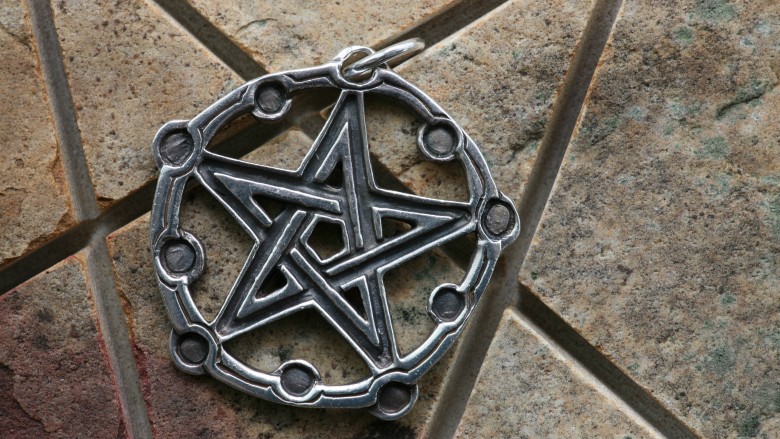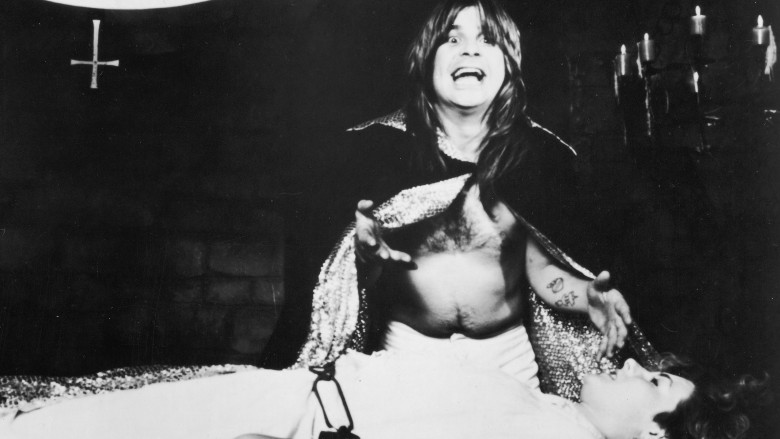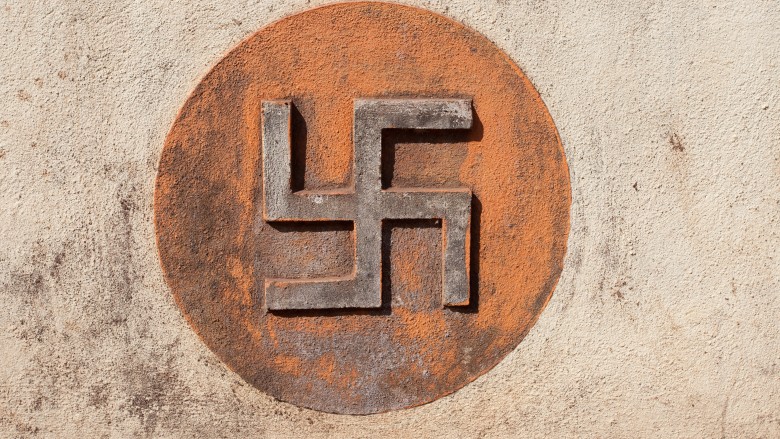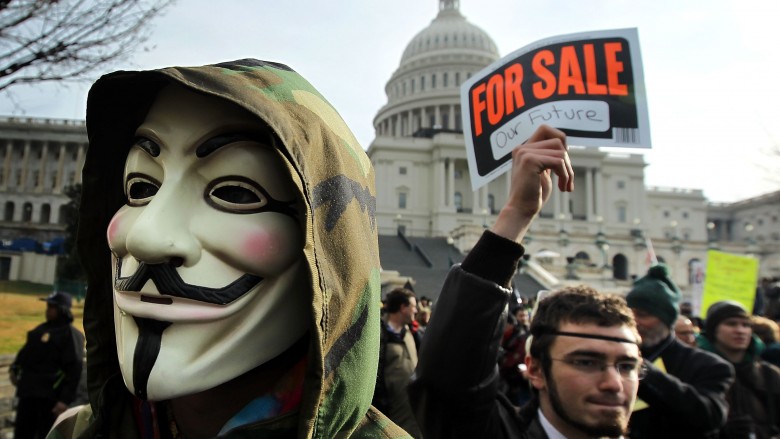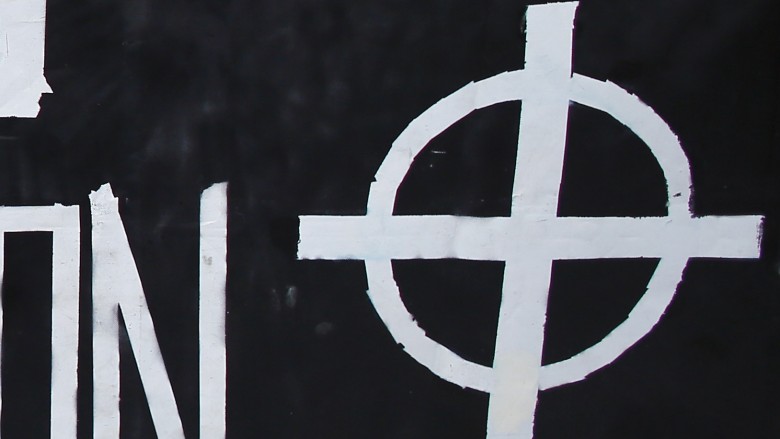Famous Symbols That Originally Meant Something Completely Different
Symbols have power and meaning, but much like the leftover pizza in your fridge, what starts out as beautiful and perfect can easily turn into something horrifying. Some symbols we've known all our life have a much, much different meaning buried deep in the past. As is our wont, we're now digging deep into the garbage bins of history to show you all the nastiest, weirdest, grossest bits we can find. You're welcome.
Hook 'em horns
They're known as devil horns, hook 'em horns, or the rock-on sign. No matter how you know them, the sign — made by a pinky and a pointer poking out, making horns out of your hands — is always seen as something raucous, if not downright demonic.
However, the symbol did not begin that way. When the sign actually began, it was a sign to ward off evil. So how'd it become the sign we know and love? Well, Ronnie James Dio — the singer — started doing it as parts of his shows, and people just got the idea it was evil and demonic because Dio just looks like a guy who would summon Satan to help him hit the high notes.
But actually, he learned of the sign from his grandmother, who taught him it was a sign to ward off the evil eye — a look that caused bad luck. So every time you do that symbol, you're practicing a small bit of magick. Congrats, all you witches and wizards, you.
Pentagram
If you're anything like us, then the first time you saw a pentagram was in some horror movie, where it was probably scrawled in blood above a murder victim. Or carved into the murder victim. Look, all we know is it definitely was drawn with blood, because it's a symbol of evil, right?
Well, no, not exactly. While it's definitely not a Christian symbol now, it's still a positive symbol, used by witches all over to represent spirituality — the point at the top — triumphing over the world. Except, here's the thing — before that, it was still seen as a positive thing, but this time by Christians. There are even references to the pentagram being a devil deterrent in the famous "let's make a deal, with the devil!" play Faust. Imagine if a shield somehow became representative of a sword — that's basically the change that the pentagram has undergone over the years.
That all said, there is some validity to the upside-down pentagram being evil, because there it represents the physical world over the spiritual world. However, that's about the same level of evil as "I'd rather eat a cheeseburger than go to church," so your mileage may vary with that.
Pink triangle
If you only know about the Pink Triangle from the Weezer song named that, then you need to learn some more queer history. See, the pink triangle is used across America as a symbol of gay pride — it's a mark that says, "Hey, look, I'm gay, ain't that great." It's branded on buildings, as part of organizations, and worn on people's clothes in a way to mark them as queer.
That whole "in clothes" thing is actually how it started, just in a very, very negative way. See, back in the Holocaust (yep, we're going there), people were arrested for a bunch of different things. The soon-to-be victims were marked with different triangles, according to their "crimes." You know the overlapping yellow triangles for Jewish prisoners, but there were a bunch of others, including one for communists, one for normal criminals, and one for homosexuals. Guess what color their triangle was? Pink, indeed.
Yep, a symbol of horror from the Holocaust later got reclaimed as a symbol of hope and pride, because honestly, what other choice did the queer community have? It's not like there were a bunch of great options for them in the first place.
Upside-down cross
You might know what the upside-down cross is, depending on how bad of a mothershutyourmouther you are. It's commonly worn by the HARDCORE!!, who use it as a symbol of how awesomely non-Christian they are. The cross is pretty Christian, right? So by turning it upside down, see, you're being disrespectful, and thereby being like "See, I'm not a Christian!"
Well, sorry to ruin your blasphemous fun — that is the exact opposite of the meaning an upside-down cross had in the first place. See, for a long time, it was representative of the Crucifixion of Saint Peter, one of Jesus' disciples and the very first Pope ever. When he was crucified (because at one point, Christians were legitimately super-oppressed) he insisted he be crucified upside-down, because he felt he wasn't good enough to be crucified the way that Jesus was. So the symbol somehow went from a sign of penitence to God, to a sign of how much cooler and more awesome Jesus was, to an FU to the entire religion. Except that last one is wrong wrong wrong — if you want to be a cool rebel, but you're a Christian, rock that upside-down cross. Otherwise, steer clear, you're embarrassing yourself.
The swastika
The Swastika is basically the closest thing we have to an actual symbol of the Devil. It's the thing that people who advocate for mass genocide wear to show that, despite them losing a huge war years ago, their ideology hasn't gone away. And, oh yeah, the people who killed over eleven million people less than eighty years ago? It was their symbol too. It's basically steeped in evil, like a fine brewed tea made of Satan's pee.
Except, here's the thing: when it started, it was a good thing. Yeah, that's right. Before Adolf Hitler decided to take a big ol' dump on the world, the swastika was a sign of well-being and good fortune. It was first used thousands and thousands of years ago, across many different religions, even showing up in their temples. And then, Nazis. Always Nazis, ruining literally everything they touch — lives, religious symbols, frogs, funny little mustaches, everything. Hitler designed the Nazi flag based on the swastika, and ruined it forever. Then he killed himself — so at least he did one good thing in his life.
The Guy Fawkes mask
Guy Fawkes, Guy Fawkes / Twas his intent / to blow up King and Parliament, but then he failed. Ha, loser. Let's make fun of how poorly this revolution failed by burning effigies of him once a year on a day we specifically put aside to mock his failure at killing people. Again: ley-hoo-zay-hurr. Also, welcome to the UK, where this is an actual thing that's done. Yes, in some places of the world, the Guy Fawkes mask is a happy symbol of revolutions failing. But then a comic book came in and changed everything.
After British writer Alan Moore wrote V for Vendetta (and especially, after the movie adaptation produced by the Wachowski Sisters), the Guy Fawkes mask slowly became to resemble what it was in the book — a symbol of anonymity, a reclamation of the idea that "hey, why don't we, a ragtag group, go ahead and change the entire fabric of society?" It went from a symbol of how great it was that Guy Fawkes failed in his revolution, to a symbol of resistance and, well, revolution. Hopefully they fare better than poor Guy did, for their sakes.
Celtic cross
"Nazis. I hate these guys," says Indiana Jones and, buddy, are we there with you. Because Nazis, at their core, are impossibly bad at everything, none of them could actually manage to create new evil symbols, so all of their symbols are bastardized copies of good things. For instance, the Celtic Cross — a symbol of Neo-Nazism everywhere, a declaration that you need just a big whopping punch in the jaw — started out as a symbol of the Sun.
Now, the Sun is pretty rad. We all know it. it keeps us warm, it grows our fruits and veggies, and Earth would just be a frigid, lifeless rock without it. But back in ancient times, it was seen even more powerfully, as a symbol of life and God. That's what the Celtic Cross began as: a symbol of life and heat, and one that the Nazis took and turned into a sign of, uh, being just the absolute worst. Because, remember, like their leader, Nazis are really bad at creativity, so they just steal everything. Including the freaking Sun!
Arm and hammer
You know this one, right? Arm and hammer — it's that symbol of those household products, like laundry and bleach and baking soda. So what, you wonder? Did it start out as a symbol dirt and stains?
Well, no, not exactly. But see, Arm and Hammer is now the brand name of a bunch of different products, and the capitalist country that created them. But we didn't just throw in the term "capitalist" there because we're on Twitter a lot. See, an arm and a hammer originally started out as representing a god, which is cool. So cool, in fact, the symbol eventually became a symbol for labor. It was put on flags, it represented unions — it was basically like how Rosie the Riveter became a symbol for awesome feminism.
Laborers adored it so much, in fact, that when they attempted to create a new political system, to fight back against the capitalistic society that felt was using and exploiting them, the laborers used the arm-and-hammer sign for their organization: the Socialist Party of America. That would be its most popular incarnation — as a symbol for communism. Then, naturally, some capitalists saw the popularity of it, went "neat symbol," and created a company with it as the logo. Above all, meaning is yours to mold ... if you have enough money.
Easter eggs & Christmas trees
It's Christmas time! Deck the halls and put up the Christmas tree. But before you do, maybe you'd like to know the history of that beautiful Christmas tree. See, back before Christianity even existed, the trees we now use to summon Santa were still seen as special and basically magical, because they lasted all year. They were a sign of the return of the Sun (whom some treated as a God), and displayed during the Winter Solstice, as a sign that this time was almost over and soon there'd be spring. Many, many different religions used evergreens as a symbol of celebration of the return of the sun and a mark of their God. But now you're putting it up as a symbol for Jesus? Pagan nonsense.
But hey, you only need to worry about that once a year, right? Wrong. That's because, before you know it, we're into the second-most sacred Christian holiday: Easter. There's actually a pagan symbolism in those eggs you hide all over the yard for kids to find, and in what laid it. See, rabbits are actually a symbol of fertility (take two guesses as to why) and, as such, were used to represent birth and new life in many pagan holidays. Somehow (we don't get it either), this morphed into a magical egg-laying bunny in Germany.
So that's two holidays that don't mean at all what you thought. But don't worry — Thanksgiving still means "eat absolutely everything in sight," and probably always will. You can trust Thanksgiving.
Cross
The cross is one of the most famous symbols in the world — it's a sign of Christ's death, our redemption, and Christianity in general. Everywhere you go, you can see crosses covering everything as a mark of Christianity. But see, before Christ even existed, there were still crosses being used as a symbol, by people in dozens of different countries. In almost every place you can think of, there's evidence of crosses being used to represent something holy. Some were seen as representations of life, and some were symbols of nature worship. But all of them are examples of the cross being a powerful religious symbol long before Christianity even came about.
Heck, it wasn't until the time of Constantine (the dude who decided which books of the Bible should count) that the cross became a symbol of Christianity. Was it adopted from the pagans? Probably, but it's got a neat justification behind it, being the thing that Jesus was crucified on. But what about the other religions — why such unification over making a glorified T a holy symbol? While we're not sure exactly why people are so drawn to the cross, our guess is that it's because God actually looks like a giant T. Namely, Mr. T. Don't pity the sinner, pity the fool.


